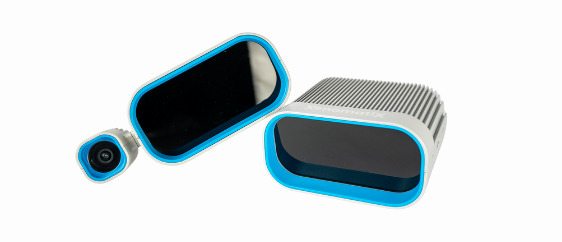XenoLidar Xavia
She Sees Everything

Xavia is a true solid-state lidar, with no moving parts. It can measure objects as far as 140 meters—and as close as just a few centimetres at the same time. Traffic signs and other reflective surfaces are reliably detected thanks to the onboard reflector handling, which allows Xavia to observe dark objects even when they are positioned next to highly reflective ones.
Xavia floods the entire scene with laser light to ensure nothing is missed yet remains completely safe as a Class 1 eye-safe product. And we promise a fair and accessible price.
Key Features
-
True solid-state
-
Sensor fusion with 2D Camera
- Superior Reflector Handling
- ”Only pay for what you need” Approach
- Quasi-Zero Stand-Off
Advanced Reflector Handling enables accurate detection of low-reflective objects at a distance, even when high-reflective objects are nearby. Common high-reflective materials—such as traffic signs, license plates, reflectors on cones, trucks, or safety vests—do not distort the point cloud.
Xavia offers an exceptionally wide dynamic range, allowing it to measure both low- and high-reflective surfaces simultaneously within the same frame. This feature is optional. If your application involves high-reflective materials, be sure to enable it in your system configuration.
Key Benefits of Reflector Handling
-
Detects hard-to-see objects
-
Avoids confusion from shiny objects
-
Gives cleaner, more accurate 3D data
-
Optional feature
The lidar and camera are integrated and pre-aligned into a single system, working together to provide synchronized depth and visual data. Lidar point clouds and camera images are captured simultaneously, with both sensors operating at the same frame rate.
Camera images are transmitted directly to the user via an Ethernet connection and are neither processed nor modified by the lidar. A camera SDK is provided, allowing your application to directly access the synchronized images. The camera’s field of view (FOV) exceeds that of the lidar. It is up to the user to decide whether to utilize the entire camera FOV or only the region that overlaps with the lidar’s FOV. The camera can be mounted on either the left or right side of the lidar. Mounting on the right (when viewed from the rear) is the preferred configuration.
Key Benefits:
- Combines rich color
- Accurate distance for better decision-making
Xavia is an all-in-one lidar unit with all processing handled internally to deliver high-quality point clouds—no external controller or additional computation on your PC is required (aside from your own application).
Xavia includes extra computing power for running point cloud analysis directly on the device. XenomatiX offers development services for on-board applications. The unit also features a GPIO port, enabling on-board apps to output digital signals based on analysis results—for example, triggering an alert when an object comes too close.
Xavia delivers complete scene coverage in every measurement frame—with no gaps or blind spots. Each frame uniformly illuminates 100% of the scene, both horizontally and vertically, using laser light. Illumination uniformity exceeds 90%, ensuring consistent detection across the entire field of view.
This eliminates the risk of missing objects between scan lines or laser spots.
Note: Xavia uses a fixed illumination pattern across all frames. The measurement sequence is not configurable, but each frame consistently covers the full field of view without interruption.
Xavia outputs only high-quality measurements, with a strict signal quality threshold of over 95%. While this is a high bar for lidar systems, it ensures reliable, trustworthy point clouds—free from false positives. For example, when Xavia is pointed at empty space (e.g., open air), no measurements will appear, accurately reflecting the absence of objects.
The resolution is the same in horizontal and vertical direction and is always the same: 0,3 deg. This is the space covered by every single pixel on the detector. Yet, thanks to the uniform illumination, smaller objects will be visible, as long as they return more light than the background. At 20m, a 10cm wide object corresponds to about 0,3 deg. This object will still be visible at 40m where it covers 0,15deg as long as there is no more reflective object in the background.